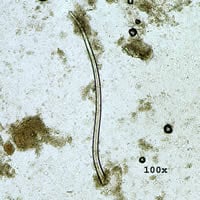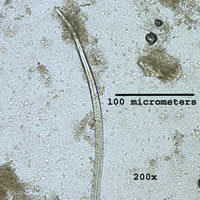
Monthy Case Studies - 2003
Case #102 - February, 2003
A research study was conducted in a small community in Haiti to assess the prevalence of intestinal parasitic diseases in school-age children. The formalin-ethyl acetate (FEA) concentration procedure was performed on stool specimens collected from all participants. The following images show an object measuring 280 µm in length that was seen on one of the stool smears (Figures A and B). What is your diagnosis? Based on what criteria?

Figure A

Figure B
Answer to Case #102
The object shown was an artifact (plant hair) and a diagnosis was given of No Parasites Found (NPF). Although it resembled a first-stage rhabditoid Strongyloides sp. larva in size (180 to 380 µm in length) and shape, no morphologic structures were identifiable (e.g., buccal capsule, digestive tract, or genital primordium).
More on: Artifacts
Images presented in the monthly case studies are from specimens submitted for diagnosis or archiving. On rare occasions, clinical histories given may be partly fictitious.
 ShareCompartir
ShareCompartir


